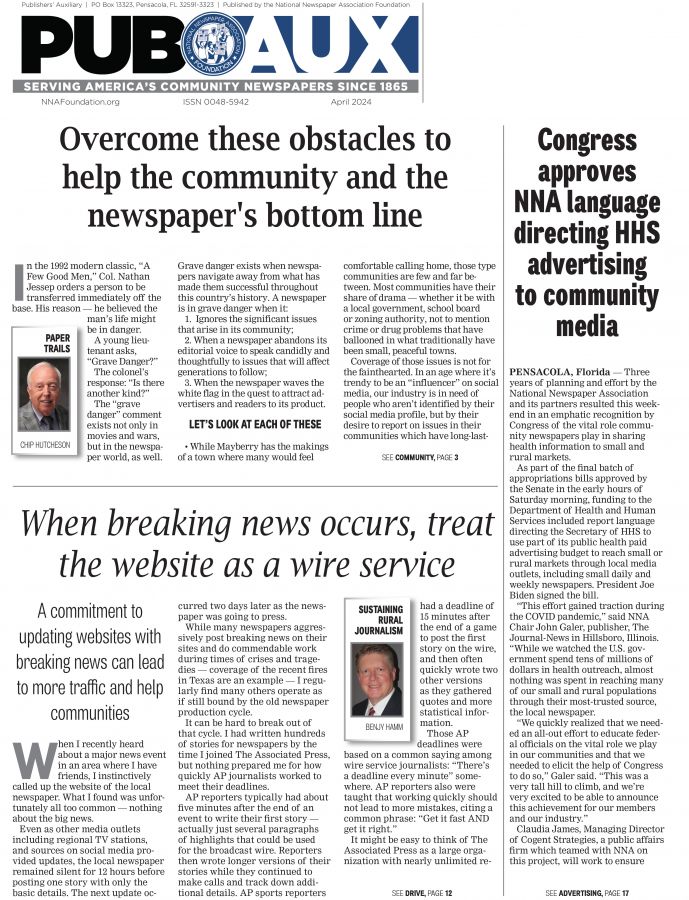Phones, guns, immigration, economy, mail, hospitals and farming—all issues for rural papers
Jun 5, 2013
Rural America is increasingly having problems with telephones. Long-distance calls to rural places aren’t going through, many rural areas aren’t well served by wireless technology, and the nation’s biggest phone company wants to shed itself of state laws requiring phone companies to offer basic landline service.
The Rural Blog touched on all those issues recently, as well as many others affecting rural America: guns, immigration, rural migration, the rural economy, Saturday mail, rural hospitals and agriculture, as well as spotlighting some good rural journalism.
The FCC is investigating the problem of completing long-distance calls to rural areas, which is caused by a mix of technology, public policy and phone companies’ desire for more profits. Harold Feld, senior vice president of Public Knowledge, which advocates open access to the Internet and other technologies, summed up the problem well in an article for the Daily Yonder, and we excerpted and linked to it at http://bit.ly/11d0Dqi.
We’re also tracking the efforts of major telephone companies to be deregulated by state legislatures, saying it would give them more freedom to invest in technology—including broadband expansion in rural areas. The opposing argument, that it could leave poor people and those on fixed incomes without reliable landline service, won out in Kentucky this year for the second time. Now the big battleground is Illinois, but other states are involved. We wrote about it most recently at bit.ly/ZqVNFQ.
The world is increasingly wireless, but the shift is slower in rural areas because of topography and sparse population. Range Networks says it has come up with a new kind of wireless system “that talks to standard phones over a radio-access network the same way existing cellular systems do, but uses voice-over-Internet protocol on the back end,” and we took note of it at bit.ly/XRd64w.
Keeping up with technology is critical for rural schools and their students. Many schools have outdated software and slow Internet connections, and many students’ homes lack high-speed broadband or any Internet connection. Ida Lieszkovsky of Stateimpact Ohio, a collaboration of public radio stations, reported on the problems in that state and we noted it at bit.ly/14vSt13.
Ohio recently began the first course for U.S. educators in how to use guns to stop a shooter in school. Joshua Jamerson of The Columbus Dispatch reported on it and we picked it up at bit.ly/1001OoN.
Immigration and migration
The Senate immigration reform bill would affect almost every sector of the U.S. economy, but none more than agriculture. It would create a new “blue card” program that would make it easier for experienced farm workers who are in the U.S. illegally to move one step closer to obtaining a green card and legal residency. We reported details at bit.ly/10U8l6o.
Amid the immigration debate, The Associated Press changed its Stylebook to rule out the use of the term “illegal immigrant,” saying the change was consistent with other changes that avoid “labeling people.” We reported on it at bit.ly/12muGwW.
There’s immigration, and there’s migration—the movement of people within the country. It’s well know that young adults are migrating from rural areas, but less known that older adults are moving to rural areas, especially if they have recreational amenities. The Carsey Institute at the University of New Hampshire did a study, and we excerpted it with a county-by-county map at bit.ly/15mcoPl.
The Census Bureau tracks migration through Medicare payments and tax returns. The Daily Yonder produced a map showing which counties gained and lost from migration between 2010 to 2012, and we reproduced it at bit.ly/11d9vw7. The Yonder also tracks county-by-county rural unemployment; our latest item on that is at bit.ly/11fVXNp.
When more than 25 percent of a county’s workforce commutes to the core county or counties of a metropolitan area, the Census Bureau adds that county to the metro area. That means many largely rural counties, and much of America’s rural population, are in metro areas. Minnesota Public Radio did a story on the phenomenon and we picked it up at http://bit.ly/13j3Epc.
Health, horses and journalism
A recent study concluded that death rates are rising for heart and pneumonia patients on Medicare at critical-access rural hospitals, but the first director of the federal Office of Rural Health said there are reasons for that which have nothing to do with the quality of care at small, rural hospitals. We noted the study at bit.ly/15fs1HZ and the response at bit.ly/XGqZjS.
Six years ago, Congress effectively banned horse slaughterhouses in the U.S., then two years ago changed its mind, but no horse abattoirs have opened, perhaps because the Department of Agriculture didn’t want them to. Now President Obama’s proposed USDA budget would rule out any money for inspections of such facilities, which is what Congress did in 2007, but a Farm Bill amendment to do that was withdrawn. USDA may have slow-walked a New Mexico company’s application to open a horse abattoir, but now has inspected it, and Agriculture Secretary Tom Vilsack says it could soon be open for business. Our item is at bit.ly/14XUPWi.
You’re welcome to reprint our Rural Blog items as news; they always contain credit for the original source, and if you use one, we’d appreciate a credit line. If you do or see good rural journalism, tell us about it so we can put it on blog, at http://irjci.blogspot.com. © Al Cross 2013
Al Cross edited and managed weekly newspapers before spending 26 years at The (Louisville) Courier-Journal and serving as president of the Society of Professional Journalists. Since 2004 he has been director of the Institute for Rural Journalism and Community Issues, based at the University of Kentucky.







